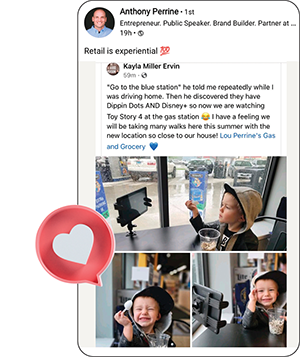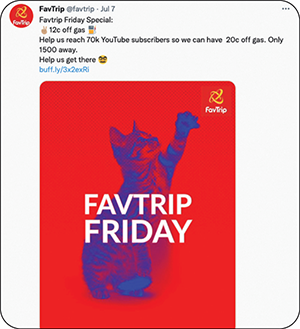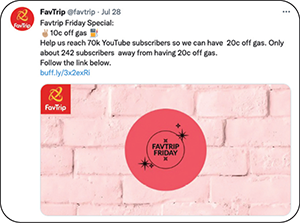Independent convenience store retailers wear multiple hats and are constantly juggling roles—they’re the operations manager, the human resources director, marketing coordinator, lead merchandiser ... oh, and somehow, they need to fit an effective social media strategy into the mix.
For many small-business owners, the idea of running social media accounts is daunting and an added burden to an already full plate. But a social media presence is worth it, according to Ariel Norwood, senior director of marketing engagement at Bounteous, a digital marketing agency that counts Wawa as a client. More than 60% of consumers believe brands need a strong social presence to succeed in the long run, and nearly 80% are willing to make a purchase after having a positive experience on social, according to data from Bounteous’ partner Sprout Social.
“A good social media presence is a growing consumer expectation,” said Norwood. “Social is one of the easiest and fastest ways to connect with consumers one on one, enabling direct, immediate access to a brand’s loyalist fans.”
Mike Flebotte, partner with The Business Accelerator Team, a consultancy providing marketing, strategy and business consulting to the convenience industry, agreed.
“Most customers are having conversations about [a retailer’s] brand whether they’re following them or not, and I think it’s important for smaller retailers especially to be part of that narrative,” said Flebotte.
For Lisa Dell’Alba, president and CEO, Square One Markets, being on social media is important for her company’s brand and also for forging a deeper connection with her customers.
“It’s important to be at the table with social media to bring about brand awareness but also to communicate with folks,” she said. “I think social media really exposes the human side of what we do. It’s not professional advertising—it’s saying, ‘hey we’re people, and we’re connecting to the people we serve.’”
 SMALL FOOTPRINT, BIG IMPACT
SMALL FOOTPRINT, BIG IMPACT
So how can a small convenience retailer make a big impact on social media? Flebotte said that having a large social media presence doesn’t require a robust social media team. One person can be sufficient, he said.
“It’s more about [the] consistency ... of pushing messages about the brand’s role in its community and what kinds of values and promotions they’re offering to their customers.”
Anthony Perrine, owner of Lou Perrine’s Gas and Groceries, which has two stores in Kenosha, Wisconsin, agrees that consistency is key.
“To have a successful social media campaign as a little guy you need content,” he said. “You have to just do it, do it, do it and be OK with a lot of posts or tweets or pictures that don’t get a lot of likes, but you’re constantly staying in front of somebody.”
Perrine’s strategy on social media has evolved over the years. He admits that in the beginning, he cared most about getting followers and engagement.
“I was able to gain a lot of traction by being edgy and risqué, and I realized that, sure, I got a lot of followers ..., but I was also offending a lot of people,” he said. “I was creating a customer base of people that were edgy and liking it, but if they’re edgy and like it on social, they’re edgy, and they act a different way inside my store.”
Three years ago, Perrine decided he wanted his brand to have a different image—one that is more family friendly and welcoming.
“Instead of trying to be so edgy and get everybody talking, I can accomplish the same thing by being a little bit tamer,” he said.
 THE COMPETITION IS FIERCE
THE COMPETITION IS FIERCE
Just about every brand has a voice on social media, including your competitors, and consumers are watching to see how you stack up. Flebotte said that consumers are comparing small retailers to bigger ones based on an evolving expectation of what a social media presence should offer.
“For smaller retailers, [social media] can be a very cost-effective tool that helps them compete with larger brands from the perspective of sharing voice,” he said.
According to Norwood, the brands that make the largest waves on social media develop content that reflects who they are and fearlessly speaks to their audience, and small businesses shouldn’t be afraid to look at the competition.
“Have a working knowledge of what your competitors are doing in social media,” she advises. “Identify what you love about their work, what you don’t and where you think your brand can step in and do something different or better.”
Dell’Alba, whose company has 12 locations in Pennsylvania, said she also looks to the competition for inspiration.
“A lot of it is seeing what they do, and if they’re not a direct competitor of yours, I think it’s OK to emulate them and look at the way they go about it,” she said.
 WHAT ABOUT TIKTOK?
WHAT ABOUT TIKTOK?
FavTrip, which has three locations in the Kansas City, Missouri, area, has 46,000 followers on TikTok after about a year on the platform. FavTrip’s president, Babir Sultan, said the original intent of joining TikTok was to build brand awareness, and it’s paid off, but it can be time consuming.
Because Sultan sees value in TikTok, he hired a freelancer to take on the job of editing videos. He found the editor through the website The Editors Connection. “It’s been a welcome change,” he said. “Between running operations and doing videos, it’s quite a bit of work.”
Lou Perrine’s Gas and Groceries also has a TikTok account, and Perrine admits it’s the account the business has the most fun on. Perrine said he typically is the one to come up with an idea for a video and then his employees will film it, though his employees do come to him with ideas, which he will either green light or red light. However, like Sultan, Perrine also said creating TikToks is time-consuming.
“If you’re going do a video worthwhile, it’s going to take you a good 30 minutes by the time you do the music, edit it ... versus a Tweet, Facebook post or Instagram, which takes two seconds,” he said.
 GETTING IT DONE
GETTING IT DONE
Perrine said that each Sunday, he would list what he wanted to post on social media for the week ahead, and he would preload the corresponding images into his phone. Then he would post to his accounts throughout the week based off his schedule.
“You’re literally spending 15 minutes of your week getting the content needed, knowing what you’re going to post about and then just spending a couple minutes a day posting instead of trying to do it all or be creative each day for 30 to 45 minutes,” he said.
Dell’Alba asked one of her employees if he would post to social media for the company and paid him per post. She said she created the position around the individual.
“Sometimes it’s about finding the right person to do it,” she said. “There’s a lot of people out there that really understand the pulse of the brand and are the ones having the conversations with customers. Sometimes it’s easier to trust them to do it.” Sultan concurred.
“With TikTok, as soon as I allowed our employees to start engaging or creating content, that was a big relief for me. I should have done that a lot sooner,” he said.
GIVE US YOUR ONE SOCIAL MEDIA TIP.
 Mike Flebotte
Mike Flebotte
"It's acknowledging that your brand on social media isn't just what you say it is. It's also what your customers contribute to it."
 Ariel Norwood
Ariel Norwood
"Give yourself time! Plan ahead, and align your content calendar with key campaigns and relevant cultural moments."
 Anthony Perrine
Anthony Perrine
"I mix up my strategies on the different social media platforms.For anybody using social media you have to know your audience."
 Babir Sultan
Babir Sultan
"Don't be afraid. ... Just get started somewhere. Don't worry about the views and engagement. ... Just keep showing up everyday, and you have to enjoy it."
 Lisa Dell'Alba
Lisa Dell'Alba
"For a small business, you can't be afraid to start. I think you have to be willing to take the risk. It's a conversation, and it's about being human and really connecting with people in a social environment."